Chapter 2: Jammu and Kashmir - The
Background
Jammu and Kashmir
has three distinct components - Hindu majority Jammu, Buddhist dominated
Ladakh in the North and predominantly Muslim populated Valley, besides
what is under Pakistan occupation. Pakistan's eyes are set on Kashmir on
the pernicious two-nation theory. Never mind the fact that despite partition
of the sub-continent into India and Pakistan in 1947 by the British, India
still has the world's second largest Muslim population, around 120 million,
next only to that of Indonesia.
It is a fact of history that Hindus, Muslims,
Sikhs and Buddhists have lived in peace and amity in the State for centuries.
When the rest of the subcontinent was up in flames, lit by the communal
torch, it was Kashmir which stood out of the circle of holocaust, a "shining
example", in Mahatma Gandhi's words of "secularism". Not a drop of blood
was shed in Kashmir while thousands perished in communal fury all around.
The State had been ruled by the Mughals, followed
by Afghans, Sikhs and finally the Hindu Dogras. The Sikh ruler Maharaja
Ranjit Singh entrusted the principality of Jammu and adjacent areas to
Gulab Singh, his Dogra General. Gulab Singh brought large areas including
Ladakh, Zanskar, Gilgit and Baltistan under his control. The latter was
succeeded as Maharaja by Ranbir Singh. And Ranbir Singh was succeeded by
Maharaja Pratap Singh whose reign opened a new chapter in the history of
modern Kashmir. The British wanted a strong government to tackle the socio-economic
problems of the frontier State. In 1889, Maharaja Pratap Singh was deprived
of his administrative authority which was to be handled by a Council of
Regency under the control of a British Resident. The Maharaja undertook
a tour of the frontier post up to Gurez and beyond and issued orders for
immediate redress of the grievances of the people inhabiting these areas.
With improvement on all the fronts, the British again restored full powers
to the Maharaja in 1921.
The consolidation of Dogra rule in Jammu and Kashmir
coincided with the strengthening of the Indian freedom movement under Mahatma
Gandhi's leadership. The freedom struggle was soon to find an echo in several
princely States and nowhere with more ardor than in Kashmir. By 1931, anti-Dogra
sentiment in the State had struck solid roots with Sheikh Mohammad Abdullah
and some others, including the Mirwaiz Maulvi Yusuf Shah, the Muslim high
priest of the Valley, in the lead. The Maulvi, it soon transpired, was
accepting a monthly stipend from the Maharaja and this, among many other
factors, forced Sheikh Abdullah to steer away from Muslim communal politics
as symbolized by the then Muslim Conference. By the mid-1930s Sheikh Abdullah
had moved to a secular base and formed the National Conference, comprising
Hindus, Muslims and Sikhs. The National Conference inevitably found itself
drawn towards the Indian National Congress and thus was the foundation
laid of an abiding friendship between Sheikh Mohammad Abdullah, Jawaharlal
Nehru and Mahatma Gandhi.
Mohammed Ali Jinnah, the founder of Pakistan,
tried hard to woo the Sheikh and indeed visited Srinagar on a couple of
occasions only to be rebuffed by the National Conference. Jinnah's known
arrogance did not help him either. He dismissed his best bet in the Valley,
Maulvi Mirwaiz Yusuf Shah, as a "rotten egg", as Sheikh Abdullah recalls
in his autobiography "Aatish-e-Chinar". The Sheikh again recalls the supreme
contempt which Jinnah had for the Kashmiri people. According to Sheikh
Abdullah, when a National Conference activist, Ali Mohammad Tariq, asked
Jinnah soon after the partition of the sub-continent whether the future
of Kashmir would be decided by the people of Kashmir, he was stunned by
Jinnah's riposte: "Let the people go to hell." The people of the so-called
Azad Kashmir have known ever since how much their Pakistani benefactors
have cared for them.
At the dawn of independence when the great see-saw
about the future of the princely states was on, Sheikh Abdullah was still
in jail and was released only when the Dogra Maharaja saw himself slipping
into a mire. With Pakistani tribals, aided and abetted by the Pakistani
army, commanded by Major General Akbar Khan, invaded the Valley, Sheikh
Abdullah had just been out of the Maharaja's jail. The Pakistan Army's
active involvement in and following the tribal raids of 1947 and infiltration
of raiders supported by the Pakistan army into Kashmir before the outbreak
of the 1965 conflict is acknowledged by one of the highly regarded Pakistani
Generals, Lt. Gen. Gul Hasan Khan, in his memoirs and by Altaf Gohar in
his biography of Field Marshal Ayub Khan. With the Maharaja still undecided
about his future course of action, Sheikh Abdullah and his National Conference
organized a volunteer corps, unarmed for the most part, to defend the Valley.
The volunteers, drawn from all communities, were asked to protect the life,
property, honor and dignity of the Kashmiri people. Luckily for Kashmir,
the tribal invaders did not move as fast as they could have. They accorded
a higher priority to rape, arson and loot. Of this later.
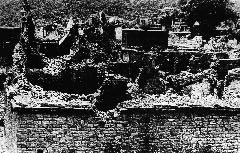
Destruction by raiders.
Contrary to what Pakistan has been saying about
its role then, it had sent a special emissary to Kashmir to try and persuade
the Maharaja to accede to Pakistan. The emissary failed in his mission.
Consequently, Pakistan, in total disregard of the Standstill Agreement
it had signed with the Maharaja, cut off its supplies of essential commodities
such as salt and petrol; it also stopped its supply of currency notes and
small coins to the Imperial Bank in Kashmir. Since the roads joining Kashmir
to the rest of India ran through Pakistan, things became more critical
despite the protest lodged by the Maharaja. That was only the beginning.
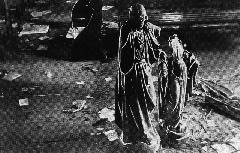
Church in Baramulla desecrated by raiders.
Pakistan now sent tribal hordes from the North
West Frontier Province (NWFP) to browbeat the Kashmiris. Muzaffarabad,
now capital of the so-called Azad Kashmir, was over-run in a day or so.
But the tribals were more interested in rape and loot and that is perhaps
what saved Kashmir in the end. The situation in Srinagar became tense.
The Maharaja rallied his small army in an attempt to defend the State.
In her book, "Halfway to Freedom", Margaret Bourke-White describes the
plunder by the raiders:
'Their buses and trucks, loaded with booty, arrived
every other day and took more Pathans to Kashmir. Ostensibly they went
to liberate their Kashmiri Muslim brothers, but their primary objective
was riot and loot. In this they made no distinction between Hindus, Sikhs
and Muslims."
"The raiders advanced into Baramulla, the biggest
commercial center of the region with a population then of 11,000, until
they were only an hour away from Srinagar. For the next three days they
were engaged in massive plunder, rioting and rape. No one was spared. Even
members of the St. Joseph's Mission Hospital were brutally massacred."
This tribal invasion was no accident, according to Sheikh Abdullah. It
was a diversionary tactic created by the newly formed State of Pakistan.
"The withdrawal of British forces from the tribal belt had left these people
without any livelihood. The ruler of Pakistan feared that these lawless
people may proceed to plunder Peshawar and other big cities of Pakistan.
They were, therefore, asked to proceed to Kashmir, having been assured
of their bounty through plunder of the countryside. Pakistani leaders were
hoping to reap a double benefit: getting rid of the tribals and bringing
Kashmiris to their knees.
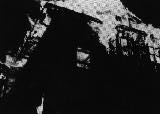
Wooden buildings burn fiercely during a raid.
When the tribals refused to budge from Baramulla,
Abdul Qayyum Khan, an NWFP Pathan leader, sent their religious leader,
Pir Manti, to persuade them to advance towards Srinagar," the Sheikh wrote.
According to confirmed reports as described by Sheikh Abdullah in his autobiography,
Pakistan agents in Srinagar city decided to destroy all the bridges so
that if the Indian Army was despatched, its movement could be sabotaged.
National Conference volunteers were posted at the bridges and Hindus and
Muslims alike were prepared to guard their national honor, having heard
about the atrocities inflicted on innocents by the rival people. The ruler's
appeals to Pakistan were of no avail. The raiders caused havoc in different
parts of Kashmir. The Kashmir state troops were incapable of offering effective
resistance to the raiders and the threat to the Valley became grave. Unable
to prevent the raiders from committing large-scale killings, loot and arson,
the Maharaja requested the Government of India on October 26, 1947 that
the State of Jammu and Kashmir be allowed to accede to India.
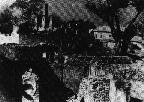
The town of Pattan in Kashmir - after a raid.
An appeal for help was also simultaneously received
by the Government of India from the National Conference which was the largest
popular organization in Kashmir and which had fought for the people's rights
and agitated for the freedom of Kashmir from the Maharaja's rule. The National
Conference also supported the request for the State's accession to India.
To those who question Sheikh Abdullah's credentials one need only quote
President Ayub Khan of Pakistan who had just then received the Kashmiri
leader in May 1964. He had this to say: "Sheikh Abdullah is a lion hearted
leader." And Allama Iqbal, whom Pakistan hails as its philosopher poet,
said: "Sheikh Abdullah wiped the fear of the tyrant from the hearts of
the people of Kashmir." The Instrument of Accession was accepted the next
day by the Governor General of India, Lord Mountbatten. The first contingent
of the Indian Army flew into Srinagar on October 27, to repulse the invaders.
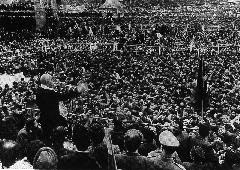
Sheikh Abdullah addressing a rally at Lal
Chowk in Srinagar.
| 


















No one has commented yet. Be the first!